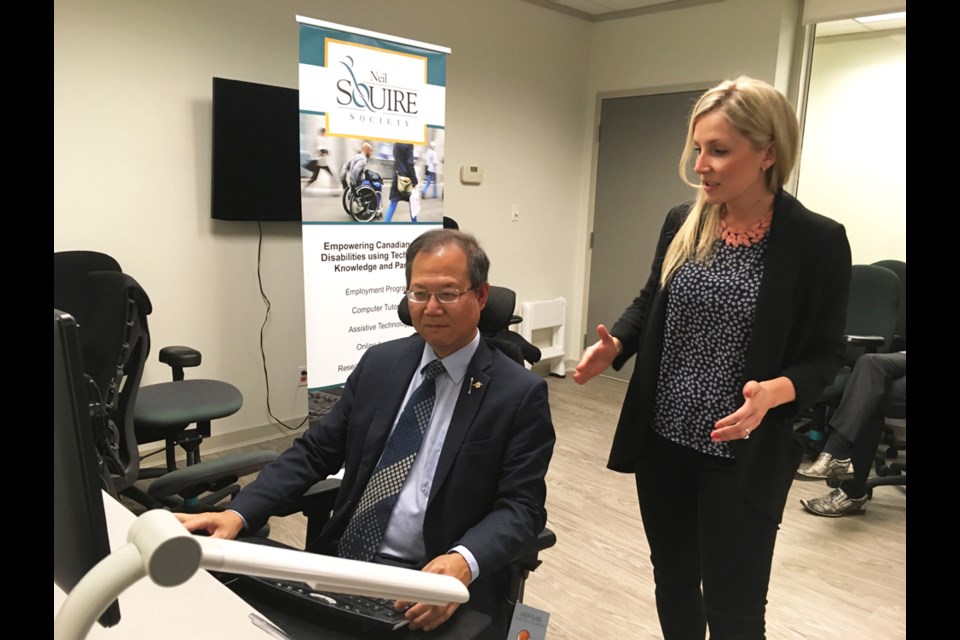"This is a client I will never forget,” says Laura Bergstrom.
He was one of the first to enroll in the Neil Squire Society’s Technology@Work program, and Bergstrom was his occupational therapist.
According to Bergstrom, he was a lovely guy who worked the same job for 20 years, but his vision was deteriorating. He was a purchaser, which involved scrutinizing tiny numbers on spreadsheets and warehouse boxes. This man, as Bergstrom tells it, would lean in so far to read things that the boxes and his computer monitor were inches from his nose. He did this for eight hours a day, five days a week. The strain caused debilitating exhaustion, neck pain, back pain and headaches. The fatigue was so intense, all he could do was go home after work and sleep. Things had gotten so bad, he figured he would have to quit.
“It was just awful,” Bergstrom says. “He was the nicest guy, and he was so good at his job.”
The man heard about the society’s Technology@Work program, which helps make workplaces more comfortable for people with disabilities. Bergstrom and her team intervened and implemented several changes. They brought in software that made the text on this computer screen larger, coloured and with more contrast. They installed an electronic magnifier to scan and read documents; one with a portable tablet so he could take pictures of the small numbers on the warehouse boxes. They also affixed a monitor arm so he could bring his computer screen closer to his face, without hunching forward, and they replaced his broken chair with a more ergonomically correct one. The man was also having trouble commuting on the bus, because he couldn’t see the intersections and didn’t know where to get off. Bergstrom hooked him up with a small GPS device that fed regular location updates into an earpiece to help him navigate.
“The accommodations that were put in place were, … I think he said ‘life changing,’” Bergstrom says. “He could continue to do the work he loves without feeling the exhaustion and the pain.”
The Technology@Work program has been running since spring 2015, and more than 400 people have received help to make their workplaces more accommodating. The Neil Squire Society is known for helping people with disabilities in the workplace, but disability is a loose term when it comes to qualifying for the program. It simply means a condition that is either permanent, temporary or episodic in nature. It could be physical or cognitive, from an injury or repeated movements or related to a progressive disease. Neck pain, back pain, carpal tunnel syndrome, arthritis, low vision or blindness, a spinal cord injury, multiple sclerosis or cerebral palsy are all conditions that send clients to the program.
The types of workers Neil Squire helps are also varied, from cashiers and CEOs, to lawyers, artists, fishermen and the self-employed.
Under B.C. law, employers have a “duty to accommodate” disabled people in the workplace.
That could mean bringing in new keyboards with larger key symbols, more ergonomically friendly chairs or auto-dictation software that allows people without limbs to type using their voices. For example, the society is working with one client with impaired vision who might use a camera that’s fitted to his glasses with a small earpiece, and this device will read whatever text he points to with his finger.
These things can get expensive – a fancy, comfortable ergonomically correct chair on display runs for more than $1,000 – but most of the costs, if not all, are covered by the government through the program.
“I think there’s this fear that accommodations are expensive,” Bergstrom says. “But that’s where the program comes in. We can help offset those.”
Since September is Disability in the Workplace Month, the society invited Burnaby MLA Richard Lee to the office for a mock assessment. As an interesting aside, Lee used to work at TRIUMF with Bill Cameron, the society’s original founder and the man who invented the sip and puff communication system used by quadriplegics. Bergstrom walks Lee through a typical assessment a client would undergo, adjusting his chair, headrest and armrests for optimum comfort and health. Ergonomics and the correct body positioning are important if you’re using assistive technology, she adds.
The way Bergstrom sees it, meaningful work gives people a sense of purpose in life, and people shouldn’t be denied that experience because of a disability, be it cognitive, physical, injury-related or the result of a progressive disease.
“It’s really important to have purposeful work in your life,” she says. “You have to have things in your life that give you meaning. (A disability) shouldn’t prevent you from participating in these things, like work for example. And that’s where assistive technologies come in.”
To apply for the program, go to www.neilsquire.ca and fill out an online application or call 604-473-9363 or drop by the office at Unit 400, 3999 Henning Dr. in Burnaby.



